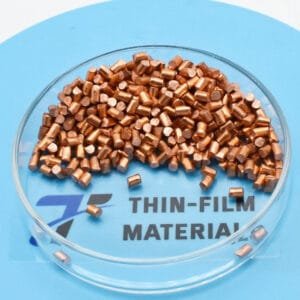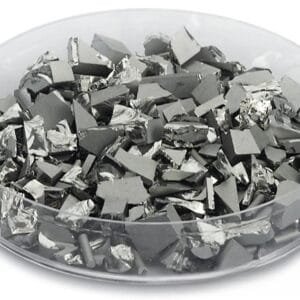Cobalt Aluminum Evaporation Materials Description
TFM provides high-purity Cobalt Aluminum (Co/Al) evaporation materials, engineered for reliable performance in thermal and electron beam (e-beam) evaporation systems. These alloy materials combine the magnetic and catalytic characteristics of cobalt (Co) with the lightweight conductivity and corrosion resistance of aluminum (Al), making them ideal for use in multilayer thin films, magneto-optical coatings, and metal-insulator-metal (MIM) structures.
Cobalt-Aluminum films are particularly valued for their:
Tailorable electrical and magnetic properties
Strong adhesion to dielectric and metal substrates
Thermal and chemical stability in vacuum environments
Compatibility with patterned deposition processes
Cobalt Aluminum Evaporation Material Specification
| Property | Value |
|---|---|
| Chemical Composition | Co/Al alloy (e.g., 80:20, 70:30, 50:50 by atomic or weight %) |
| Purity | ≥ 99.95% (3N5) or higher |
| Appearance | Metallic gray or bluish pellets, slugs, or granules |
| Form | Pellets, shots, slugs, or custom-pressed pieces |
| Melting Point | ~1350–1450 °C (depends on composition) |
| Density | ~6.5–8.0 g/cm³ (varies by ratio) |
| Evaporation Method | Thermal evaporation, e-beam evaporation |
| Typical Sizes | 1–10 mm pellets, 0.25–1 g pieces (custom formats available) |
| Packaging | Vacuum-sealed in moisture-proof containers with inert gas backfill |
Custom alloy ratios and pellet shapes available upon request.
Applications of Cobalt Aluminum Evaporation Materials
Spintronics and magnetic tunnel junctions (MTJs)
Thin film read/write heads
Reflective and absorptive optical coatings
Barrier and contact layers in microelectronics
Nanostructured alloy studies and MEMS fabrication
Handling and Storage
Store in a dry, inert atmosphere; aluminum in the alloy can be reactive to air or moisture.
Handle with non-metallic tweezers or gloves to avoid contamination.
Avoid direct contact with acids or corrosive vapors.
Packaging
TFM ensures Cobalt Aluminum evaporation materials are carefully packaged in anti-static, vacuum-sealed containers or argon-filled glass vials. Each package is clearly labeled with material composition, purity, and batch number for traceability and quality assurance.
Get Contact
TFM manufactures and supplies Co/Al evaporation materials in a variety of alloy compositions, shapes, and purities to meet your thin film coating needs.
Contact us for quotes, custom orders, or technical guidance.


 MSDS File
MSDS File



Reviews
There are no reviews yet.